PERFORMANCE AIRSPEEDS FOR THE SOARING CHALLENGED
NOTICE: This file was mirrored from http://www.jdburch.com/polar.htm - now offline
After eighteen years administering
FAA practical tests, I have concluded that a lot of glider pilots and
flight instructors are not entirely comfortable with the relationship
between performance airspeeds and polar curves.
If graphs look like way too much math for you,
maybe the following explanation will help.
Suppose we have four Schweizer SGS 1-26 gliders, identical
except for color. For our test, we will line them up and fly them
at the speeds and sink rates in the following table:
| Glider
| 
| 
| 
| 
|
| Airspeed
| 26 Knots
| 31 Knots
| 42 Knots
| 62 Knots
|
| Sink Rate
| 1.8 Knots
| 1.6 Knots
| 1.9 Knots
| 3.2 Knots
|
 |
If the four gliders start together and proceed in the same direction
at their respective speeds and sink rates, a side view will look like
this. After one minute, their positions relative to their starting
points will be shown by the distance graph (for simplicity we will
let one knot = 100 feet per minute - the error is trivial). That means
that the blue glider has flown 2600 feet horizontally and 180 feet
vertically. Similarly, the green glider has flown 3100' horizontally
and 160' vertically, the yellow glider 4200' horizontally and 190'
vertically, and the red glider 6200' horizontally and 320' vertically.
|
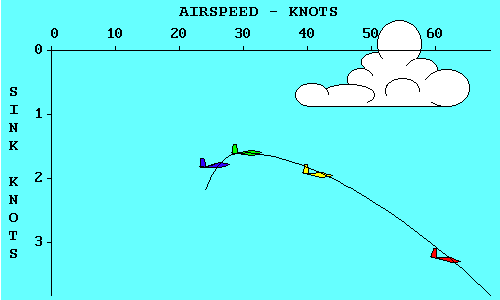 |
Now if we connect the gliders with a smooth curve and change the
distance scales to speed scales, we have just drawn a polar curve
for the Schweizer SGS 1-26.
|
So, what can we do with a polar curve?
 |
Lets pretend we started this exercise with the gliders 320 feet above
the ground. The red glider is already touching down (actually crashing
because we didn't allow any room for a flare). If we continue the
descent of the other gliders until the blue and yellow gliders also
reach the surface, we see several things. First, the yellow glider
goes farther than any other while losing 320 feet. The blue glider
touched down about the same time, but doesn't go nearly as far. The
green glider is still in the air, but will crash on top of the red
glider if it isn't moved quickly.
|
Two of these gliders represent significant points on a polar curve.
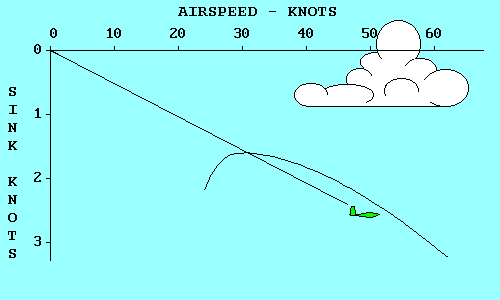 |
The green glider has the lowest sink rate of any. It will keep you in
the air for the longest time, but will not go very far. Note
that its glide path intersects the polar curve at its highest point.
If we move up from the highest point on the polar curve to the airspeed
scale we find that the minimum sink speed for a SGS 1-26 is 31 knots
(35 mph). If we move horizontally to the left we find that the minimum
sink rate is 1.6 knots (160 feet per minute).
|
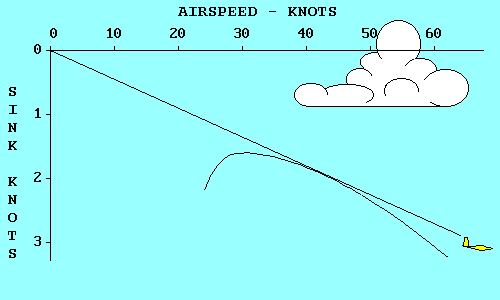 |
The yellow glider has the best glide ratio of all. That means that it
will glide farther in still air than any other glider, for a given loss
of altitude. A line from the origin (0, 0 point) of the graph, that is
tangent to (just touches) the polar curve represents the glide path of
the yellow glider. If we move up from the point where the line touches
the polar curve to the airspeed scale, we find that the speed that
produces this best glide is 42 knots (48 mph). If we move
horizontally to the left from the tangent point we find the
corresponding sink rate, 1.9 knots (190 feet per minute).
|
If air was always still, that's all we'd need to know about polar
curves. Minimum sink speed would keep us in the air for the longest time
and best glide speed would allow us to go the greatest distance.
Fortunately for glider pilots, air frequently moves both vertically
and horizontally. When it goes up faster than our sink rate within it
we can climb. When it goes down we need to modify our best glide speed
to optimize our flight through sinking air.
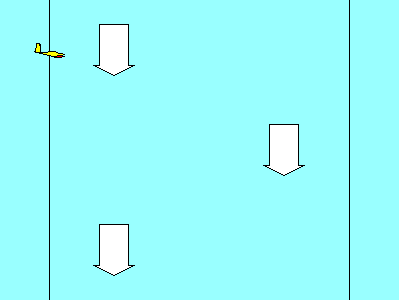 |
To see how sinking air
affects our glide let's compare the red and yellow gliders.
If both enter an air mass that is sinking at 300 feet
per minute (3 knots), their sink rates will
increase accordingly. The yellow glider is now sinking at 4.9 kts
(1.9 within the air mass plus 3 for the air mass sink rate). The red
glider is now sinking at 6.2 kts (3.2 + 3.0). Both enter the air mass at
the same altitude; our objective is to come out the other side with
the least loss of altitude. Although the red glider is sinking faster,
it is also moving horizontally much faster (62kts vs 42 kts). The
result is that it gets out of the sinking air at a higher altitude
than the yellow glider.
The red glider has a better glide ratio,
relative to the ground, than the yellow one even though the yellow
glider has a better glide ratio relative to the air mass.
|
By now you may have noticed that the speeds for our gliders in
these examples were not selected randomly. The green glider is flying
at Minimum Sink Speed, the yellow glider at Best Glide Speed (also
called best L/D Speed because the glide ratio in still air is
numerically equal to the ratio of lift to drag), and the red glider is
flying at the Speed to Fly for a SGS 1-26 flying in an air mass that
is sinking at 300 feet per minute. For now we will define Speed to Fly
as the speed that results in the flattest glide in both convection
and wind because it was so defined by the FAA in the predecessor to the
Practical Test Standards. Now let's look at how Speed to Fly can be
determined from the polar curve for any air mass sink rate.
 |
In our previous examples our polar curve showed performance relative
to the air mass in which the glider was flying. It was valid relative
to the ground only in still air. To be valid relative to the ground
the curve must be displaced in the direction and by the amount that
the air mass is moving. In this example the air is sinking at 300 feet
per minute (3 kts), so we move the curve down 3 kts.
To determine the Speed to Fly for any condition, we draw a line from
the origin that is just tangent to the curve. Then we draw a line
straight up from the tangent point to the speed scale. In this case
the Speed to Fly is 62 kts. Did that surprise you?
|
If you were trying to determine Speed to Fly from a polar curve drawn
on a piece of paper (maybe for a pilot examiner), you would find it
inconvenient to redraw the curve for each air mass sink rate.
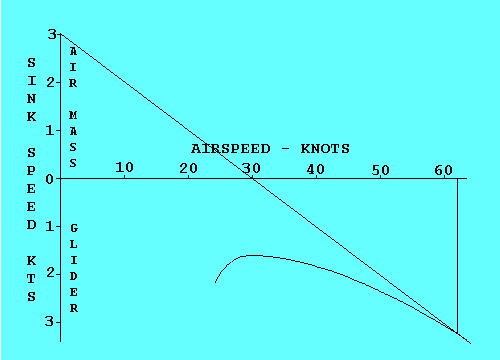 |
An easier way to accomplish the same objective is to raise the origin
of the graph by an amount equal to the air mass sink rate and then
draw a tangent to the original curve from that point. To keep our
examples consistent, let's assume a 3 knot air mass sink rate and
move the origin up 3 knots. Now the tangent to the original curve
occurs at the same 62 knots we found in the previous example. When
using this method be sure to remember that the glider sink rate is
the sum of its sink rate within the air mass and the sink rate of the
air mass itself. In this case it is 6.2 kts (air mass sink of 3 kts
plus glider sink within the air mass of 3.2 kts = 6.2 kts).
|
We can use the same technique to determine the Speed to Fly for any
motion of the air mass.
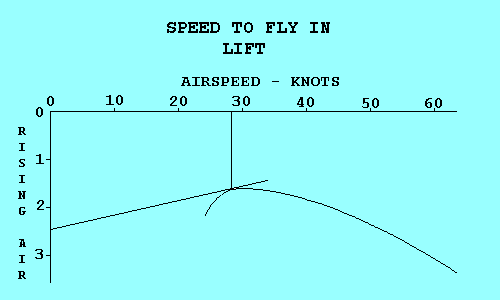 |
If the air is rising we displace the origin
down by an amount equal to the rate at which the air is going up, and
then draw a tangent from that point to the polar curve. This gives a
valid speed only if we plan to fly straight through the lift. If we
plan to circle in the lift, other factors determine the speed that
will optimize our climb rate.
For a headwind we displace the origin to the right, using the airspeed
scale to determine how far we move it. For a tailwind we displace the
origin to the left.
|
We can also combine vertical and horizontal air mass movement when both
exist. The example shows how to combine sink and a headwind.
You may be thinking, "This is all very interesting, but how do I use it
in the air. I'm not going to carry polar curve charts with me in the
glider and draw tangents for each condition I encounter." You are
right. The information derived here must be converted to cockpit
displays and/or rules of thumb to use in flight.
First let's discuss headwinds and tailwinds. You have to estimate their
values so a rule of thumb is as good as anything. If you were to
evaluate several different wind conditions graphically, you would find
that the tangent point moves about half as far as the origin. Thus, a
good rule would be "Add about half the estimated value of a headwind,
and subtract about half the value of a tailwind from the Speed to Fly
determined for lift or sink."
 |
For lift and sink we have an instrument in the glider to give us the
necessary information. The process used to determine Speed to Fly gives
us the sink rate of the air mass and the sink rate of the glider within
the air mass. Their total is the value that would be indicated on the
variometer. We could select a few representative values of Speed to Fly
and stick them on the panel adjacent to the corresponding variometer
readings, using a label maker. A better method is to invest in a
speed ring for the glider/variometer combination we have. The speed
ring is adjustable, but for our current definition of Speed to Fly it
should be set with the arrow on the ring pointing to "0" on the
variometer. Then when the variometer points to any rate of descent it
is also pointing to the corresponding Speed to Fly - the one that will
produce the flattest glide under those conditions. Our example shows
Speed to Fly varying from 42 kts in still air to 62 kts in 3 kt sink.
|
If you only want to know enough about performance airspeeds to pass the
FAA practical test you probably could stop here. The FAA wants you to
understand the concepts well enough so you don't do something dumb like
trying to stretch a glide by pulling back on the stick when you should be
pushing forward.
 |
Although the Speeds to Fly that we have been
discussing so far are the ones that will let you glide to that safe
landing spot if any will, they are too slow to win contests and too
slow for most cross-country flights. In these cases we are more
interested in covering the ground in the shortest time rather than
obtaining the flattest glide. That introduces a new definition of
Speed to Fly.
Credit for developing this concept of Speed to Fly is usually given to
Paul MacCready, and the speed ring discussed earlier is usually called
a MacCready speed ring. Cross-country flights utilizing thermals consist
of alternately climbing in one thermal and gliding to the next.
MacCready noted that the Speed to Fly between thermals should be
based on the strength of the thermals. If the thermals are strong you
can fly faster than the speed that produces the flattest glide. You
will lose more altitude, but you make up for it by climbing faster in
the next thermal. Thus you reach the top of the next thermal sooner
than you would have at the lower speed.
|
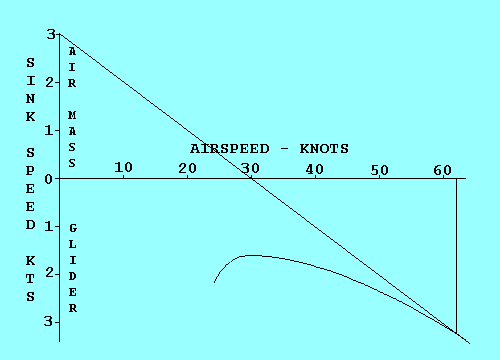 |
We can analyze Speed to Fly in this case by using the same technique
we used for flattest glide in sinking air, except that we offset the
polar curve origin
by the rate of climb we expect in the next thermal instead of air mass
sink rate. To illustrate the similarity we assume a climb rate of 3 kts and
see that the graph is identical to the one with 3 kts sink except for
the labels. It shows that the Speed to Fly between thermals in still
air is 62 kts if you expect to climb at 3 kts in the next thermal.
An added benefit is that the average cross-country
speed, including the time spent circling in thermals,
can be estimated by the point on the airspeed scale where the tangent
line crosses the scale.
|
Now we see why the speed ring can be rotated about the variometer.
If we expect our climb rate to be 3 kts, we set the arrow on the ring
opposite where the vario indicates 3 kts climb. Note that the Speeds to Fly
also move so that a higher speed is indicated for all sink rates. In
this example the Speed to Fly in still air is 62 kts, just as the
graph predicted. The sink rate in still air at this speed is
3.2 kts, as it has been for the red glider throughout this analysis.
 |
Some pilots might question using a climb rate in the next thermal,
one that has not yet been attained, to set the speed ring. They should
try to remember the last time they made a decision with complete
information. In this case one could base the estimate on the climb
rate in the last thermal, modified by an assessment of conditions
ahead and whether they appear to be improving or deteriorating. Once set,
the value selected is still subject to change. A good way to think of
the MacCready setting is that it represents the minimum climb rate that the
pilot is willing to stop for. As altitude decreases and the prospects of
landing out increase, the prudent pilot will accept weaker thermals, and the
MacCready ring should be set accordingly. A really desperate pilot should set
the ring to zero to maximize the area to be searched for a thermal.
|
The performance data used here is based on a SGS 1-26 at 575 pounds
gross weight, as shown in Appendix A, The Joy of Soaring.
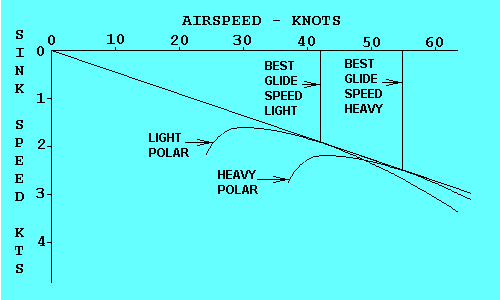 |
A different polar curve exists for the same glider at every gross
weight. As the weight increases the polar moves down and to the right
and becomes a little flatter, but retains approximately the same shape.
Both airspeed and sink rate increase for equivalent points on the
curves, but their ratio remains the same. Both heavy and light glider
achieve the same best glide ratio, as shown here,
but the heavy glider does so at a
higher speed. This is the reason for carrying ballast to improve
glide performance when the thermals are strong enough, even though
the climb rate suffers.
|
© 2000 Jim D. Burch 602-942-2734
jdburch@worldnet.att.net













